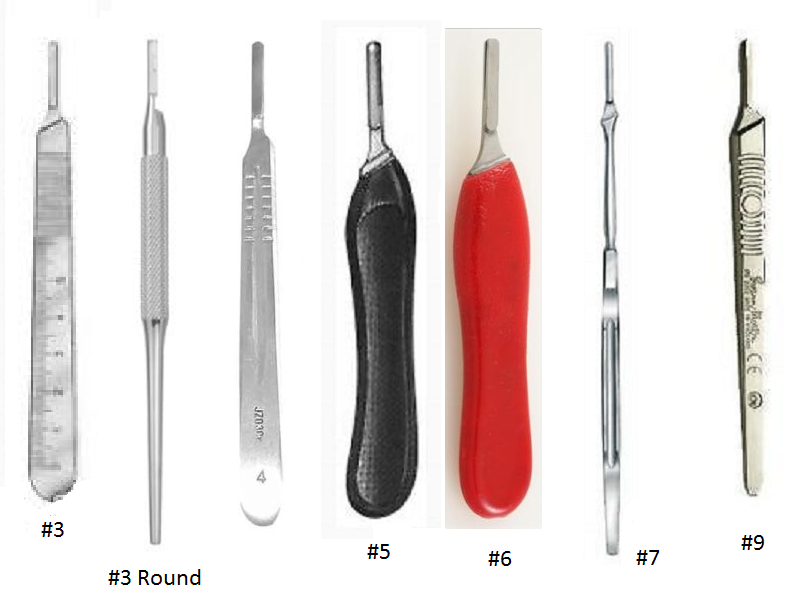
The thickness of graft represented by each calibration is learned by experience. The position of the adjustable roller is controlled by a screw marked with calibrations at one end and a lock at the other. Because the thickness of the graft is controlled by the adjustable roller, only a moderate amount of practice is required to develop the expertise necessary to achieve a uniform, split-thickness graft of the desired thickness.
SCALPEL BLADE SIZES CHART SKIN
The Watson skin grafting knife, a modification of the Braithwaite knife, can harvest a graft 100 mm (4 inches) wide, uses disposable blades, and is fitted with an adjustable roller in front of the blade to control the depth of the cut ( Figure 25-8). Large grafts necessary to cover wounds of horses can be cut with a variety of knives designed specifically for harvesting skin. Scalpel blades, double-edged razor blades, and surgical straight razors are sometimes used to harvest small, split-thickness grafts from humans, but these types of dermatomes are of little use for harvesting skin grafts from horses, because they can be used to harvest only relatively small grafts and because their use requires considerable technical expertise to obtain a graft of consistent thickness. James Schumacher, in Equine Surgery (Fourth Edition), 2012 Hand Instruments Ethylene oxide or gas plasma sterilization (see Chapter 9) is recommended, because heat and chemicals will dull the reusable blade. The reusable scalpel with attached blade has a single advantage over the disposable units: the blade will not detach when used in heavy connective tissue, within joints, or in deep tissue planes, where visibility and access for removal are poor. The primary advantage of disposable blades is that replacement blades are consistently sharp. A detachable blade should not be used in joints or deep within heavy connective tissues, where they could break off and be lost from view. 22 to 24 (see Figure 11-3, F) and is used in less delicate surgical procedures, such as debulking granulation tissue and resecting large wounds with proud flesh. 4 handle (see Figure 11-3, D) accepts larger blades such as No. 12 blade is used for periosteal stripping (see Figure 11-3, E). 11 blade is frequently used for stab incisions during arthroscopic surgery, and the No. 15 blade is a smaller version in a similar shape (see Figure 11-3, E). 3 scalpel handle is the most frequently used and comes in different shapes (see Figure 11-3, A-C).

In most clinics, scalpel handles with different detachable disposable blades are used ( Figure 11-3).

Scalpels are available with detachable blades, as disposable units with blades attached, and as reusable units with blades attached.

Auer, in Equine Surgery (Fourth Edition), 2012 Steel Scalpels


 0 kommentar(er)
0 kommentar(er)
